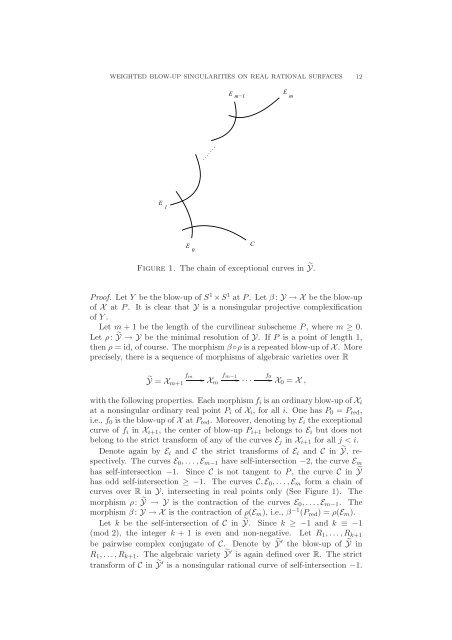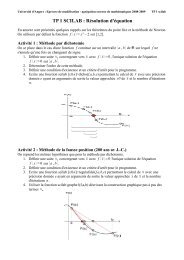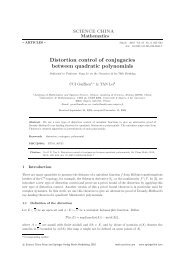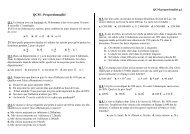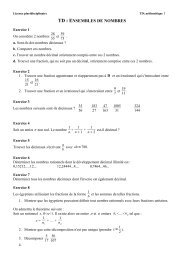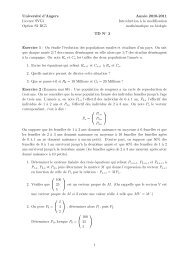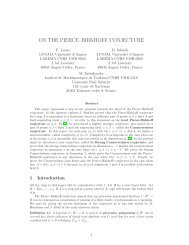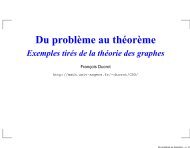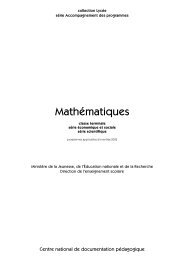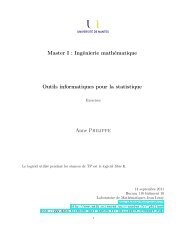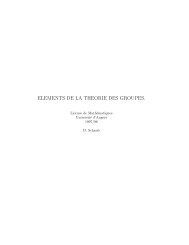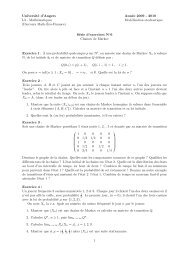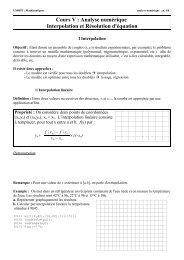automorphisms of real rational surfaces and weighted blow-up ...
automorphisms of real rational surfaces and weighted blow-up ...
automorphisms of real rational surfaces and weighted blow-up ...
Create successful ePaper yourself
Turn your PDF publications into a flip-book with our unique Google optimized e-Paper software.
WEIGHTED BLOW-UP SINGULARITIES ON REAL RATIONAL SURFACES 12<br />
E<br />
1<br />
E<br />
0<br />
E<br />
E<br />
m−1 m<br />
Figure 1. The chain <strong>of</strong> exceptional curves in Y.<br />
Pro<strong>of</strong>. Let Y be the <strong>blow</strong>-<strong>up</strong> <strong>of</strong> S 1 ×S 1 at P. Let β: Y → X be the <strong>blow</strong>-<strong>up</strong><br />
<strong>of</strong> X at P. It is clear that Y is a nonsingular projective complexification<br />
<strong>of</strong> Y .<br />
Let m + 1 be the length <strong>of</strong> the curvilinear subscheme P, where m ≥ 0.<br />
Let ρ: Y → Y be the minimal resolution <strong>of</strong> Y. If P is a point <strong>of</strong> length 1,<br />
then ρ = id, <strong>of</strong> course. The morphism β ◦ρ is a repeated <strong>blow</strong>-<strong>up</strong> <strong>of</strong> X. More<br />
precisely, there is a sequence <strong>of</strong> morphisms <strong>of</strong> algebraic varieties over R<br />
fm<br />
Y = Xm+1<br />
<br />
Xm<br />
C<br />
fm−1<br />
<br />
· · ·<br />
f0 X0 = X ,<br />
with the following properties. Each morphism fi is an ordinary <strong>blow</strong>-<strong>up</strong> <strong>of</strong> Xi<br />
at a nonsingular ordinary <strong>real</strong> point Pi <strong>of</strong> Xi, for all i. One has P0 = Pred,<br />
i.e., f0 is the <strong>blow</strong>-<strong>up</strong> <strong>of</strong> X at Pred. Moreover, denoting by Ei the exceptional<br />
curve <strong>of</strong> fi in Xi+1, the center <strong>of</strong> <strong>blow</strong>-<strong>up</strong> Pi+1 belongs to Ei but does not<br />
belong to the strict transform <strong>of</strong> any <strong>of</strong> the curves Ej in Xi+1 for all j < i.<br />
Denote again by Ei <strong>and</strong> C the strict transforms <strong>of</strong> Ei <strong>and</strong> C in Y, respectively.<br />
The curves E0,... , Em−1 have self-intersection −2, the curve Em<br />
has self-intersection −1. Since C is not tangent to P, the curve C in Y<br />
has odd self-intersection ≥ −1. The curves C, E0,...,Em form a chain <strong>of</strong><br />
curves over R in Y, intersecting in <strong>real</strong> points only (See Figure 1). The<br />
morphism ρ: Y → Y is the contraction <strong>of</strong> the curves E0,...,Em−1. The<br />
morphism β: Y → X is the contraction <strong>of</strong> ρ(Em), i.e., β −1 (Pred) = ρ(Em).<br />
Let k be the self-intersection <strong>of</strong> C in Y. Since k ≥ −1 <strong>and</strong> k ≡ −1<br />
(mod 2), the integer k + 1 is even <strong>and</strong> non-negative. Let R1,...,Rk+1<br />
be pairwise complex conjugate <strong>of</strong> C. Denote by Y ′ the <strong>blow</strong>-<strong>up</strong> <strong>of</strong> Y in<br />
R1,... ,Rk+1. The algebraic variety Y ′ is again defined over R. The strict<br />
transform <strong>of</strong> C in Y ′ is a nonsingular <strong>rational</strong> curve <strong>of</strong> self-intersection −1.


